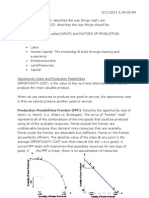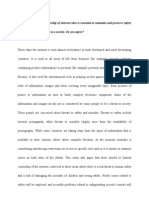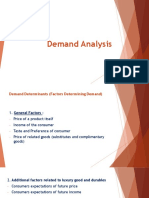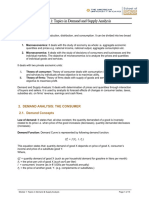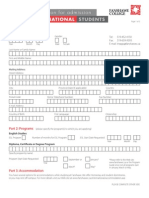Economics 1 Bentz Fall 2002 Topic 2
Economics 1 Bentz Fall 2002 Topic 2
Uploaded by
Alexander TaylorCopyright:
Available Formats
Economics 1 Bentz Fall 2002 Topic 2
Economics 1 Bentz Fall 2002 Topic 2
Uploaded by
Alexander TaylorOriginal Description:
Copyright
Available Formats
Share this document
Did you find this document useful?
Is this content inappropriate?
Copyright:
Available Formats
Economics 1 Bentz Fall 2002 Topic 2
Economics 1 Bentz Fall 2002 Topic 2
Uploaded by
Alexander TaylorCopyright:
Available Formats
DARTMOUTH COLLEGE, DEPARTMENT OF ECONOMICS
ECONOMICS 1
Dartmouth College, Department of Economics: Economics 1, Fall 02
Topic 2: Supply and Demand
Economics 1, Fall 2002 Andreas Bentz Based Primarily on Frank Chapters 2, 4
Dartmouth College, Department of Economics: Economics 1, Fall 02
Supply and Demand: Equilibrium
Example: The Market for Apartments
Andreas Bentz
page 1
DARTMOUTH COLLEGE, DEPARTMENT OF ECONOMICS
ECONOMICS 1
The (Market) Demand Curve
Demand curve for one bedroom apartments:
price (100s of $) 10 8 6 4 2 D 0 0 1 2 3 4 5 quantity (100s)
3
The demand curve for a good tells us how much of that good is demanded at each price.
The Demand Curve, contd
A downward-sloping demand curve tells us that:
The higher the price, the less the demand for the good. As price increases, fewer potential buyers can afford to buy the good (income/wealth effect). As price increases, some potential buyers substitute other goods (substitution effect).
Why?
We can write the (inverse) demand curve as p(q). Then we know that dp / dq < 0.
4
Andreas Bentz
page 2
DARTMOUTH COLLEGE, DEPARTMENT OF ECONOMICS
ECONOMICS 1
The (Industry) Supply Curve
Supply curve for one bedroom apartments:
price (100s of $) S 10 8 6 4 2 0 0 1 2 3 4 5 quantity (100s)
5
The supply curve for a good tells us how much of that good is supplied at each price.
The Supply Curve, contd
An upward-sloping supply curve tells us that:
The higher the price, the greater the supply for the good. Typically: the more you produce, the greater the production cost for each additional unit. In order to be willing to supply more, you therefore need to be able to charge a higher price for each unit. (The price must cover the production cost.)
Why?
Andreas Bentz
page 3
DARTMOUTH COLLEGE, DEPARTMENT OF ECONOMICS
ECONOMICS 1
Equilibrium
Equilibrium in the market for apartments:
price (100s of $) S 10 8 6 4 2 D 0 0 1 2 3 4 5 quantity (100s)
7
In equilibrium, prices are such that the quantity demanded equals the quantity supplied.
Excess Supply / Excess Demand
price (100s of $) S 10 8 6 4 2 D 0 0 1 2 3 4 5 quantity (100s)
8
excess supply: the amount by which quantity supplied exceeds quantity demanded excess demand: the amount by which quantity demanded exceeds quantity supplied
Andreas Bentz
page 4
DARTMOUTH COLLEGE, DEPARTMENT OF ECONOMICS
ECONOMICS 1
Price Ceiling (Rent Control)
Price ceiling at $400:
price (100s of $) S 10 8 6 4 2 D 0 0 1 2 3 4 5 quantity (100s)
9
The price ceiling causes excess demand: some potential buyers who would want to pay more than the ceiling cannot obtain the good (rationing).
Price Floor
Price floor at $800:
price (100s of $) S 10 8 6 4 2 D 0 0 1 2 3 4 5 quantity (100s)
10
The price floor causes excess supply: some potential suppliers who would want to supply at a lower price cannot sell the good.
Andreas Bentz
page 5
DARTMOUTH COLLEGE, DEPARTMENT OF ECONOMICS
ECONOMICS 1
Welfare Properties of Equilibrium
Equilibrium has nice welfare properties:
price (100s of $) S 10 8 6 4 2 D 0 0 1 2 3 4 5
Example: Prices are fixed at $400, so 200 apartments are rented. Now suppose some buyer offered $700 for one more apartment. A seller should be happy to provide one more apartment (since the cost of providing that apartment is $400).
11
quantity (100s)
Prices
Prices serve two important functions:
Rationing function:
We live in a world of scarcity. If all goods were free, how could we ration peoples unlimited wants? Since we live in a world of scarcity, we need to allocate the available resources so that: those who value goods most highly obtain them; those goods that are most wanted are being produced (suppose there is excess demand in one market: firms would have an incentive to expand production in that market, because supernormal profits can be made).
12
Allocative function:
Andreas Bentz
page 6
DARTMOUTH COLLEGE, DEPARTMENT OF ECONOMICS
ECONOMICS 1
Dartmouth College, Department of Economics: Economics 1, Fall 02
Using Supply and Demand
Changes in Demand Changes in Supply Application: Taxes Elasticity
Changes in Demand
What shifts the demand curve? (Alternatively: What causes a rise (fall) in the quantity demanded at every price?)
Changes in income/wealth: as consumers income/wealth increases, they will want to buy more of a good at each price. Prices of substitutes/complements:
complements (e.g. coffee and cream): if the price of coffee rises, your demand for cream will fall; substitutes (e.g. coffee and tea): if the price of coffee rises, your demand for tea will increase.
14
etc.
Andreas Bentz
page 7
DARTMOUTH COLLEGE, DEPARTMENT OF ECONOMICS
ECONOMICS 1
Changes in Supply
What shifts the supply curve? (Alternatively: What causes a rise (fall) in the quantity supplied at every price?)
Technology: better technology reduces cost of production. Factor prices: higher factor prices (e.g. cost of labor) means higher cost of production. Number of suppliers (e.g. computer manufacturers) etc.
15
Demand v. Quantity Demanded
Distinguish between:
a change in demand (the entire demand curve shifts), and a change in the quantity demanded (a movement along the demand curve).
Example: consumers expect a future price rise price S Example: good weather before harvest price S S
D quantity
D quantity
16
Andreas Bentz
page 8
DARTMOUTH COLLEGE, DEPARTMENT OF ECONOMICS
ECONOMICS 1
Supply v. Quantity Supplied
Similarly Distinguish between:
a change in supply (the entire supply curve shifts), and a change in the quantity supplied (a movement along the supply curve).
17
Using Supply and Demand
Example: Why do airfares increase in summer?
Example (a): carriers can expand capacity price S Example (b): carriers cannot expand capacity price S
D quantity
D quantity
Think about your own example with a fall in demand!
18
Andreas Bentz
page 9
DARTMOUTH COLLEGE, DEPARTMENT OF ECONOMICS
ECONOMICS 1
Using Supply and Demand, contd
Example: What happened during the oil price shock?
Example (a): demand for gas is (relatively) elastic price S S Example (b): demand for gas is (relatively) inelastic price S S
D quantity
D quantity
Think about your own example with a supply increase!
19
Dartmouth College, Department of Economics: Economics 1, Fall 02
Application: Taxes
Producer/Consumer Taxes (Economic) Tax Incidence
Andreas Bentz
page 10
DARTMOUTH COLLEGE, DEPARTMENT OF ECONOMICS
ECONOMICS 1
Taxes
Suppose a tax of T is levied on each unit sold by the producer.
Supply curve shifts up by the amount T. price S S Tax incidence: who bears the tax? price S S
T
quantity
D quantity
In order to cover cost, the producer needs to charge T more for each unit sold.
But some of the cost T of the tax is borne by consumers.
21
Taxes, contd
Suppose a tax of T is levied on each unit bought by the buyer.
Demand curve shifts down by the amount T. price Tax incidence: who bears the tax? price S
D quantity
D quantity
In order to buy the same quantity as before, the price has to fall by T.
But some of the cost T of the tax is borne by producers.
22
Andreas Bentz
page 11
DARTMOUTH COLLEGE, DEPARTMENT OF ECONOMICS
ECONOMICS 1
Tax Incidence
Who bears the tax depends on the elasticities of supply and demand. Example: demand.
Example (a): Relatively elastic demand curve price S S D D Example (b): Relatively inelastic demand curve price S S
quantity
quantity
Tax borne largely by producers.
Tax borne largely by consumers.
23
Tax Incidence, contd
Who bears the tax depends on the elasticities of supply and demand. Example: supply.
Example (a): Relatively elastic supply curve price S S D quantity D quantity Example (b): Relatively inelastic supply curve price S S
Tax borne largely by consumers.
Tax borne largely by producers.
24
Andreas Bentz
page 12
DARTMOUTH COLLEGE, DEPARTMENT OF ECONOMICS
ECONOMICS 1
Tax Incidence, contd
Similarly, supply and demand elasticities determine the incidence of a tax levied on consumers. Workout: Try this at home!
25
Dartmouth College, Department of Economics: Economics 1, Fall 02
Elasticity
Price Elasticity of Demand Cross-Price Elasticity of Demand Income Elasticity of Demand
Andreas Bentz
page 13
DARTMOUTH COLLEGE, DEPARTMENT OF ECONOMICS
ECONOMICS 1
Price Elasticity of Demand
The price elasticity of demand measures the responsiveness of demand for a good with respect to changes in the price of that good. Definition: The price elasticity of demand is the percentage change in the quantity demanded that results from a 1 percent change in price.
Precisely, it is: = q / q p / p
q / q q p dq p dp p = = = 1/ or, rewritten: = p / p p q dp q dq q
27
Price Elasticity of Demand, contd
dp p says that: = 1/ dq q
The price elasticity of demand at some point on the demand curve is
the inverse of the slope of the (inverse) demand curve, times the ratio of price to quantity at that point on the demand curve.
Implications: the price elasticity of demand is
(probably) different at every point on the demand curve; nonpositive.
28
Andreas Bentz
page 14
DARTMOUTH COLLEGE, DEPARTMENT OF ECONOMICS
ECONOMICS 1
Price Elasticity of Demand, contd
We call demand (at some point) elastic, if the quantity demanded is relatively responsive to changes in price.
Definition: demand is elastic whenever < -1.
We call demand (at some point) inelastic, if the quantity demanded is relatively unresponsive to changes in price.
Definition: demand is inelastic whenever -1 < < 0.
We call demand (at some point) unit elastic, if the quantity demanded changes proportionately to changes in price.
Definition: demand is unit elastic whenever = -1.
29
Price Elasticity of Demand, contd
Two extreme cases:
Perfectly elastic demand ( = -)
Demand curve with slope dp/dq = 0 price
Perfectly inelastic demand ( = 0)
Demand curve with slope dp/dq = price D
quantity
quantity
30
Andreas Bentz
page 15
DARTMOUTH COLLEGE, DEPARTMENT OF ECONOMICS
ECONOMICS 1
Using Price Elasticity of Demand
Example: Suppose you know that the price elasticity of demand for pizza at Thayer is -2.
That is, every 1% increase in price results in a 2% reduction in the quantity demanded.
Currently, 100 slices of pizza are sold, at $1.75 each. So revenue from pizza is $175. If the price of pizza increased to $2.10, would total revenue increase or decrease?
31
Using Price Elasticity, contd
An increase from $1.75 to $2.10 is an increase of 20%.
Since the elasticity is -2, we know that demand will fall by 40%.
Only 60 slices of pizza will be sold after the price increase.
60 slices of pizza at $2.10 each create revenue of $126, which is less than $175.
Total revenue would decrease.
32
Andreas Bentz
page 16
DARTMOUTH COLLEGE, DEPARTMENT OF ECONOMICS
ECONOMICS 1
Buzz Group
What effect does a 20% increase in price have on total revenue from pizza if the price elasticity of demand were -0.5?
33
Cross-Price Elasticity of Demand
We have already seen that prices of other goods may influence demand for a good.
Example: If tea and coffee are substitutes, an increase in the price of coffee will increase your demand for tea.
The cross-price elasticity of demand measures the responsiveness of demand for a good with respect to changes in the price of some other good.
34
Andreas Bentz
page 17
DARTMOUTH COLLEGE, DEPARTMENT OF ECONOMICS
ECONOMICS 1
Cross-Price Elasticity, contd
Definition: The cross-price elasticity of demand is the percentage change in the quantity demanded of one good that results from a 1 percent change in price of some other good. Precisely, for two goods, x and y, it is:
xy = q x / q x py / py
35
Cross-Price Elasticity, contd
We can now be specific about substitutes and complements: Two goods, x and y, are substitutes if an increase in price of good y increases demand for good x.
Definition: x and y are substitutes if xy > 0.
Two goods, x and y, are complements if an increase in price of good y decreases demand for good x.
Definition: x and y are complements if xy < 0.
36
Andreas Bentz
page 18
DARTMOUTH COLLEGE, DEPARTMENT OF ECONOMICS
ECONOMICS 1
Cross-Price Elasticity, contd
37
Income Elasticity of Demand
We have also seen that changes in income/wealth may have an effect on the quantity demanded of some good.
Example: As your income/wealth rises, you can afford to buy more of everything.
The income elasticity of demand measures the responsiveness of demand for a good with respect to changes in a consumers income/wealth.
38
Andreas Bentz
page 19
DARTMOUTH COLLEGE, DEPARTMENT OF ECONOMICS
ECONOMICS 1
Income Elasticity, contd
Definition: The income elasticity of demand is the percentage change in the quantity demanded of some good that results from a 1 percent change in a consumers income/wealth. Precisely, it is: q / q = m / m (where m is income/wealth).
39
Income Elasticity, contd
Income elasticity of demand is usually positive (normal goods). But there are goods of which you want to buy less as your income increases (inferior goods).
40
Andreas Bentz
page 20
DARTMOUTH COLLEGE, DEPARTMENT OF ECONOMICS
ECONOMICS 1
Income Elasticity, contd
We can now be specific about which goods are necessities and which are luxuries: A good is a necessity if quantity demanded is relatively unresponsive to changes in income/wealth.
Definition: a good is a necessity if 0 < < 1.
A good is a luxury if quantity demanded is relatively responsive to changes in income/wealth.
Definition: a good is a luxury if > 1.
41
Andreas Bentz
page 21
You might also like
- Economics for CFA 2024: level 1 in just one week: CFA level 1, #4From EverandEconomics for CFA 2024: level 1 in just one week: CFA level 1, #4Rating: 4.5 out of 5 stars4.5/5 (2)
- Micro Review PacketDocument18 pagesMicro Review Packetlhv48100% (1)
- A level Economics Revision: Cheeky Revision ShortcutsFrom EverandA level Economics Revision: Cheeky Revision ShortcutsRating: 3 out of 5 stars3/5 (1)
- Persuasive Analytical Essay ExampleDocument5 pagesPersuasive Analytical Essay Examplefreshlimesoda100% (1)
- Break-Even QuizDocument8 pagesBreak-Even QuizEricka Guisando0% (2)
- Demand Analysis-RevisedDocument54 pagesDemand Analysis-RevisedVishal ManwaniNo ratings yet
- COMM 220 Notes PDFDocument42 pagesCOMM 220 Notes PDFTejaNo ratings yet
- MGRL Econ Cha 3.0Document37 pagesMGRL Econ Cha 3.0Prasanna KumarNo ratings yet
- Half-Yearly Examination Paper 2014 Class Xii Subject: EconomicsDocument10 pagesHalf-Yearly Examination Paper 2014 Class Xii Subject: EconomicsNisha JainNo ratings yet
- Concept of Elasticty and Its Application (+ Handwritten Notes Too)Document41 pagesConcept of Elasticty and Its Application (+ Handwritten Notes Too)Aishwarya ChauhanNo ratings yet
- Elasticity and ApplicationsDocument8 pagesElasticity and ApplicationsshubhamNo ratings yet
- 04 - Demand and SupplyDocument25 pages04 - Demand and SupplyBhaskar KondaNo ratings yet
- C5 Micro EconomicsDocument31 pagesC5 Micro Economicshht2107No ratings yet
- Assignment ECON 260Document13 pagesAssignment ECON 260Mohammed AwadNo ratings yet
- CH 3 Demand and SupplyDocument48 pagesCH 3 Demand and Supplyshaheduzaman ShahedNo ratings yet
- Micro Economics: An Essay-Centric Guide: Demand and Supply / Market EquilibriumDocument8 pagesMicro Economics: An Essay-Centric Guide: Demand and Supply / Market EquilibriumKyu9930No ratings yet
- Chapter Four 2Document36 pagesChapter Four 2HananNo ratings yet
- Economics Unit 2Document27 pagesEconomics Unit 2Ratnraj NigamNo ratings yet
- EquilibriumDocument15 pagesEquilibriumHuma MughalNo ratings yet
- Economics: Chapter 2 .Managerial Economics & Business StrategyDocument20 pagesEconomics: Chapter 2 .Managerial Economics & Business StrategySwathy SidharthanNo ratings yet
- Eco 400 Assignment 1Document5 pagesEco 400 Assignment 1Muhammad Usman AshrafNo ratings yet
- Inferior Good. 1 (Positive), It Is A Luxury Good or A Superior GoodDocument14 pagesInferior Good. 1 (Positive), It Is A Luxury Good or A Superior GoodSakshi AgarwalNo ratings yet
- Eco104: Review LectureDocument35 pagesEco104: Review LectureSumaiya BasherNo ratings yet
- Micro Mid Terms Revision NotesDocument33 pagesMicro Mid Terms Revision Notesongnigel88No ratings yet
- Chap 3-Elasticity of DemandDocument22 pagesChap 3-Elasticity of DemandRabinNo ratings yet
- Demond Thoery - NotesDocument10 pagesDemond Thoery - Noteschikkegowda k gNo ratings yet
- Concept: Marginal Rate of SubstitutionDocument10 pagesConcept: Marginal Rate of SubstitutionManinder KaurNo ratings yet
- Topic 3Document7 pagesTopic 3Dave Jhaeson AlivioNo ratings yet
- BA1 Chapter 2Document37 pagesBA1 Chapter 2Umer RaufNo ratings yet
- Outline of Material CoveredDocument7 pagesOutline of Material CoveredHolly SimonNo ratings yet
- Lecture 7: Elasticity and Its Application: OutlineDocument10 pagesLecture 7: Elasticity and Its Application: OutlineJames WalkerNo ratings yet
- Economics NotesDocument80 pagesEconomics Notesgavin_d265No ratings yet
- Acctg 1102 Module 8 - Understanding Markets and Industry ChangesDocument6 pagesAcctg 1102 Module 8 - Understanding Markets and Industry ChangesElj Grace BaronNo ratings yet
- Managerial Economics 1Document9 pagesManagerial Economics 1vinodrawat74No ratings yet
- Term Paper On Micro EconomicsDocument39 pagesTerm Paper On Micro EconomicsFardus MahmudNo ratings yet
- Consumer Demand - Demand Curve, Demand Function & Law of DemandDocument14 pagesConsumer Demand - Demand Curve, Demand Function & Law of DemandNiravMakwanaNo ratings yet
- EconomicsDocument53 pagesEconomicsNora SalemNo ratings yet
- Econ Chap1 20Document24 pagesEcon Chap1 20sata.hamzaNo ratings yet
- Module 1 - Topics in Demand and Supply Analysis - HandoutsDocument15 pagesModule 1 - Topics in Demand and Supply Analysis - HandoutsAyman Al HakimNo ratings yet
- CH 04Document60 pagesCH 04Mirco SoffrittiNo ratings yet
- As1 &2Document29 pagesAs1 &2Emiru ayalewNo ratings yet
- Key Point Revision For EconomicsDocument27 pagesKey Point Revision For EconomicsdavidbohNo ratings yet
- Lecture 4Document116 pagesLecture 4Nikoli MajorNo ratings yet
- AC TC/Q, AFC FC/Q, AVC VC/Q: Between Pure Monopoly & Pure CompetitionDocument3 pagesAC TC/Q, AFC FC/Q, AVC VC/Q: Between Pure Monopoly & Pure CompetitionSadnima Binte Noman 2013796630No ratings yet
- Elasticity and Its ApplicationsDocument44 pagesElasticity and Its ApplicationsFahadNo ratings yet
- KEY-POINTS-OF-CHAPTER-4-5-MICROECONOMICS (1)Document6 pagesKEY-POINTS-OF-CHAPTER-4-5-MICROECONOMICS (1)dannguyen.31241027761No ratings yet
- MicroEconomics AssignmentDocument15 pagesMicroEconomics AssignmentMayankNo ratings yet
- Elasticity ProblemsDocument28 pagesElasticity ProblemsCheyenne Megan Kohchet-ChuaNo ratings yet
- Eec B Tech Module 1Document17 pagesEec B Tech Module 1pimavi9908No ratings yet
- Theory of Demand and Supply: Teach A Parrot To Say "Demand and Supply" and You Have An Economist (Campbell R.)Document17 pagesTheory of Demand and Supply: Teach A Parrot To Say "Demand and Supply" and You Have An Economist (Campbell R.)Ishimwe oliveNo ratings yet
- Elasticities, Demand and Supply Applications - Part BDocument31 pagesElasticities, Demand and Supply Applications - Part BDaniele naddeoNo ratings yet
- IB Exam NOTESDocument23 pagesIB Exam NOTESHarsha AmlaniNo ratings yet
- Summary of Austin Frakt & Mike Piper's Microeconomics Made SimpleFrom EverandSummary of Austin Frakt & Mike Piper's Microeconomics Made SimpleNo ratings yet
- Accounting, Maths and Computing Principles for Business Studies V11From EverandAccounting, Maths and Computing Principles for Business Studies V11No ratings yet
- Accounting, Maths and Computing for Business Studies V11 Home StudyFrom EverandAccounting, Maths and Computing for Business Studies V11 Home StudyNo ratings yet
- Accounting, Maths and Computing Principles for Business Studies Teachers Pack V11From EverandAccounting, Maths and Computing Principles for Business Studies Teachers Pack V11No ratings yet
- Economics 1 Bentz Fall 2002 Topic 4Document63 pagesEconomics 1 Bentz Fall 2002 Topic 4Alexander TaylorNo ratings yet
- Government 50: World War I OverviewDocument9 pagesGovernment 50: World War I OverviewAlexander TaylorNo ratings yet
- Government 50: Vietnam WarDocument8 pagesGovernment 50: Vietnam WarAlexander TaylorNo ratings yet
- Tuck Bridge Finance Module 12Document1 pageTuck Bridge Finance Module 12Alexander TaylorNo ratings yet
- Economcs 21 Bentz X02 Topic4Document38 pagesEconomcs 21 Bentz X02 Topic4Alexander TaylorNo ratings yet
- Idoc - Pub - 12999 Names and Attributes of Allah and Dua Ganjul ArshDocument25 pagesIdoc - Pub - 12999 Names and Attributes of Allah and Dua Ganjul ArshAAMAR ALINo ratings yet
- Sport in The City - Paper-En Casas Valle Kompier-1Document10 pagesSport in The City - Paper-En Casas Valle Kompier-1bernadeth niduazaNo ratings yet
- On BicycleDocument67 pagesOn BicycleEduardo AmirNo ratings yet
- Zhenyu (David) LuDocument2 pagesZhenyu (David) Luapi-512908304No ratings yet
- Fanshawe College Application FormDocument2 pagesFanshawe College Application Formdaljit8199No ratings yet
- Study Guide2013 14Document15 pagesStudy Guide2013 14WixadNo ratings yet
- Physiology MCQsDocument7 pagesPhysiology MCQsshair adamNo ratings yet
- ACC 113 - CH 14Document43 pagesACC 113 - CH 14ahmed.alaradi88No ratings yet
- Final Proposed Ordi Granting Honoraria To Brgy TanodsDocument3 pagesFinal Proposed Ordi Granting Honoraria To Brgy TanodsRica Carmel LanzaderasNo ratings yet
- 1.widdowson 2007 (1) - 1Document5 pages1.widdowson 2007 (1) - 1MirianNo ratings yet
- IIFT's MBA (2025-27) AdmissionDocument1 pageIIFT's MBA (2025-27) Admissionharshakoduri02No ratings yet
- Wikinomics 2Document29 pagesWikinomics 2awallis5158No ratings yet
- Y7 - End of Term Revison 9th July 2021Document16 pagesY7 - End of Term Revison 9th July 2021Darshan SandhuNo ratings yet
- Epf EcrDocument13 pagesEpf Ecrsafety.officerNo ratings yet
- Commissioning Responsibilty Matrix Rev.0 12-Nov-2014Document4 pagesCommissioning Responsibilty Matrix Rev.0 12-Nov-2014Dinesh Radhakrishnan100% (1)
- Carlos Fernando Barria Saravia-Blue ScreenDocument2 pagesCarlos Fernando Barria Saravia-Blue ScreenGokhanfatmazehra KorNo ratings yet
- Course Syllabus Intro To BusinessDocument4 pagesCourse Syllabus Intro To BusinessCrystal TaNo ratings yet
- 2 Inclusive Education in The PhilippinesDocument9 pages2 Inclusive Education in The PhilippinesBrenda BravoNo ratings yet
- 1 s2.0 S0742051X2300392X MainDocument10 pages1 s2.0 S0742051X2300392X Mainalbertus tuhuNo ratings yet
- Washington D.C. Afro-American Newspaper, April 30, 2011Document16 pagesWashington D.C. Afro-American Newspaper, April 30, 2011The AFRO-American NewspapersNo ratings yet
- Joshua Starr Transition Team Costs For Outside ConsultantsDocument90 pagesJoshua Starr Transition Team Costs For Outside ConsultantsParents' Coalition of Montgomery County, MarylandNo ratings yet
- Zola Bantu Class 60 Rapture DayDocument6 pagesZola Bantu Class 60 Rapture DayTwinomugisha Ndinyenka RobertNo ratings yet
- How Banks Create MoneyDocument40 pagesHow Banks Create Moneyfede1979No ratings yet
- Human Acts and ResponsibilityDocument4 pagesHuman Acts and ResponsibilityMaximillian100% (1)
- LGC Remedies For Collection of RevenuesDocument5 pagesLGC Remedies For Collection of RevenuesmarmiedyanNo ratings yet
- Appointment LetterDocument4 pagesAppointment LetterUpendra NeravatiNo ratings yet
- United States of America, For The Use of Wrecking Corporation of America v. Edward R. Marden Corp., (Two Cases) - Appeal of Edward R. Marden Corp, 406 F.2d 525, 1st Cir. (1969)Document2 pagesUnited States of America, For The Use of Wrecking Corporation of America v. Edward R. Marden Corp., (Two Cases) - Appeal of Edward R. Marden Corp, 406 F.2d 525, 1st Cir. (1969)Scribd Government DocsNo ratings yet
- Facebook Potential Employee Nondisclosure AgreementDocument189 pagesFacebook Potential Employee Nondisclosure AgreementSky BmsNo ratings yet


